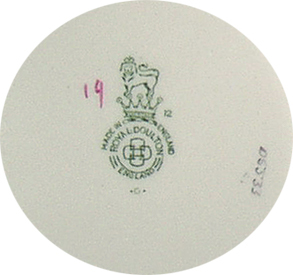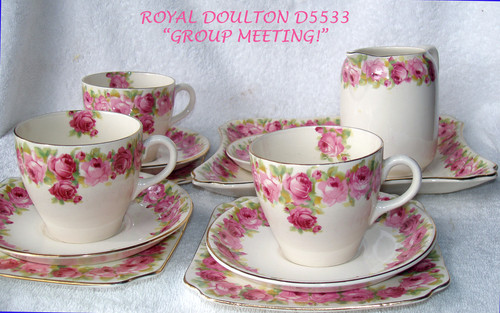BACKGROUND:
These trio teasets (offered separately or you can purchase whichever individual pieces you may need). These pieces were produced by Royal Doulton during wartime, most pieces are from 1941 (known because the number 14 is printed to the right of the backstamp and adding 1927, indicates the year of manufacture as 1941), these being the saucers and teacups. There is very slight variations in the sideplates, one is from 1939 and another 1940, again based on the backstamp numbers ... more details are below
This is the period in which the British Government introduced the Wartime Concentration scheme, specifically 1941, which restricted the operations of all potteries, some being closed down temporarily or their product focus was to be a limited domestic supply and also to the armed services. The idea was to focus on production of only necessary items and also to free up staff so that they could assist in supporting the war effort.
I do have other Royal Doulton pattern D5533 tableware but they were manufactured a few years later than these because they have the A to the left of the backstamp, which was a marking system introduced in 1942
Even with the restrictions placed upon the English potters, Doulton managed to produce what remains to be an attractive (although quite simple) product for the domestic market.
DLAT Rating: 9/10 (Darling, look at this!)
I have just been given by my wife more Royal Doulton pattern D5533 so there is more to come, take a look HERE to find them
If you wish to see the other Royal Doulton that is currently on this website, click HERE
ROYAL DOULTON - Teacup, Saucer & Side Plate
I am offering three trio sets, every piece is available separately (maximum purchasing flexibility) and as more pieces are purchased, the price is automatically discounted in the checkout.
Opaque (you cannot see the shadow of your fingers when either piece is held to a bright light)
Pattern: D5533
Hand decorated*
*Looking very closely at the techniques used for the decoration, it has characteristics of hand painting in that the artist has used a combination of solid brush strokes and "dabs", colours are often overlaid, such as around the foliage. That said though, when looking at the squared corners of the sideplates, it looks for all the world like a join line (although not well matched up) as though some sort of film transfer technique was used in conjunction with the hand decoration, but if a transfer technique was used it is nothing like the dot graphics seen on contemporary transferwares.
The design is a simple, "peaceful" continuous Pink roses garland with Lime Green & Yellow foliage.
All pieces have Gold gilding to the outer edge/rim only.
The teacups also have a single Pink rose decoration inside the mouth.
Cream coloured china base
This Royal Doulton backstamp is quite straightforward on the teacups and saucers, with the year of manufacture being 1941 (1927 + 14)
The primary backstamp is the Royal Doulton logo of the period, printed in an Olive Green with the 14 to the right side on all pieces, however the additional markings vary between pieces, Many having the D5533 handwritten in Black (but not all, particularly the teacups) and additional marks such as a W or numbers such as 14, 19 handwritten in Pink. I would presume these are the worker's numbers to identify who undertook the decoration of that piece.
THE ENIGMA!
The side plates have slightly differing markings to the underside, yes the Royal Doulton stamp is there of course but the year of manufacture varies, one sideplate was made 1935, another in 1939 and the last one in 1941. Additional to this is the fact that one sideplate (dated as 8 1935) also has an impression into the china of four characters and these are 1935, I have not seen this type of impression in other Royal Doulton pieces that my wife has handed me. Additionally, this same plate also does NOT have D5533 printed on the rear but instead is hand written the word COSIN. Strangely too, two of the sideplates which are marked 12 (1939) and 14 (1941) respectively also have the Doulton .O. at the base of the logo, which was used to indicate 1957! I can only put this down to "wartime blues" and confusion reigned and it does look to me as though these various pieces of the D5533 pattern were bought a different times across the period 1935 ~ 1941.
Times were tough back then, very tough in fact. Life was very difficult for many during and after WWII in England - What could be better than a nice "cuppa o' tea" with the Doulton? "Could you pop the kettle on the stove, Pet?" Whilst sitting in their darkened kitchen (all windows were "blacked out" to reduce light from the houses so that the enemy bombers couldn't "take their bearings" from any lights down below them.
It seems bizarre to think of how "things" were back in those days, 85+ years ago, anxiously waiting for the droning sounds of the aircraft to pass overhead, the sounds of explosions and there in front of you would be this very lovely Royal Doulton ware ...
BACKSTAMP DETAILS:
Here are some examples of the backstamps ...
EXAMPLE: TEACUP Makers mark printed on the base of the teacup (under the glazing)

EXAMPLE: SAUCER Makers mark printed on the base of the saucer (under the glazing)

EXAMPLE: SIDEPLATE Makers mark printed on the base of the sideplate (under the glazing)

COSMETIC CONDITION: TEACUPS
USED
CLEAN
NO cracks to any of the three teacups
NO discolouration to the Cream base colouring on any of the three teacups
NO tannin stains inside any of the teacups
NO chips to any of the teacups
NO damage or wear to the hand decorations on any of the three teacups
Gold gilding, which has been applied around the top rim and down the back of each handle, shows practically no wear at all
Two teacups DO show light crazing in small areas, both externally and inside the mouth of the teacup. The remaining single teacup shows no signs of crazing at all.
While those two teacups do show evidence of light crazing in places, it is nothing dramatic and no discolouration of the china has occurred.
COSMETIC CONDITION: SAUCERS
USED
CLEAN
NO cracks to any of the three saucers
NO discolouration to the Cream base colouring on any of the three saucers, topside or underneath
NO chips to any of the three saucers
NO damage or wear is apparent to the hand decorations on any of the three saucers
Gold gilding, applied only around the edge rim, appears to be substantially unworn
NO crazing is apparent when inspected either dry or wet on any of the three saucers
Two saucers have just one tiny fleabite to the undersides while the third saucer has a number of fleabites, four in total but none are large or of concern and no discolouration of the china has occurred.
COSMETIC CONDITION: SIDEPLATES
USED
CLEAN
NO cracks to any of the side plates
NO discolouration to the Cream base colouring on any of the side plates
NO scratching or knife cuts to the central area of the side plates
NO chips to any of the side plates
NO damage or wear to the hand decorations on any of the three side plates
Gold gilding, which has only been applied around the top rim, appears to be substantially unworn.
Two side plates have two each fleabites, small in size and no discolouration to the china. One side plate has no fleabites at all, interestingly this is the oldest (1935) side plate.
One side plate has some light crazing to the topside only, just a small area and not all over. The remaining two side plates do not display any signs of crazing at all.
Overall, these Royal Doulton D5533 tablewares are in very good condition, particularly considering that they are up to 90 years old now!



















